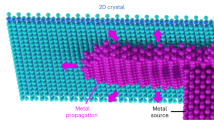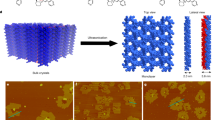Abstract
Two-dimensional (2D) materials have been studied extensively as monolayers1,2,3,4,5, vertical or lateral heterostructures6,7,8. To achieve functionalization, monolayers are often patterned using soft lithography and selectively decorated with molecules9,10. Here we demonstrate the growth of a family of 2D materials that are intrinsically patterned. We demonstrate that a monolayer of PtSe2 can be grown on a Pt substrate in the form of a triangular pattern of alternating 1T and 1H phases. Moreover, we show that, in a monolayer of CuSe grown on a Cu substrate, strain relaxation leads to periodic patterns of triangular nanopores with uniform size. Adsorption of different species at preferred pattern sites is also achieved, demonstrating that these materials can serve as templates for selective self-assembly of molecules or nanoclusters, as well as for the functionalization of the same substrate with two different species.
This is a preview of subscription content, access via your institution
Access options
Access Nature and 54 other Nature Portfolio journals
Get Nature+, our best-value online-access subscription
$29.99 / 30 days
cancel any time
Subscribe to this journal
Receive 12 print issues and online access
$259.00 per year
only $21.58 per issue
Buy this article
- Purchase on Springer Link
- Instant access to full article PDF
Prices may be subject to local taxes which are calculated during checkout




Similar content being viewed by others
References
Novoselov, K. S. et al. A roadmap for graphene. Nature 490, 192–200 (2012).
Oughaddou, H. et al. Silicene, a promising new 2D material. Prog. Surf. Sci. 90, 46–83 (2015).
Desai, S. B. et al. MoS2 transistors with 1-nanometer gate lengths. Science 354, 99–102 (2016).
Chhowalla, M. et al. The chemistry of two-dimensional layered transition metal dichalcogenide nanosheets. Nat. Chem. 5, 263–275 (2013).
Yin, K. Unsupported single-atom-thick copper oxide monolayers. 2D Mater. 4, 011001 (2017).
Geim, A. K. & Grigorieva, I. V. Van der Waals heterostructures. Nature 499, 419–425 (2013).
Eda, G. et al. Coherent atomic and electronic heterostructures of single-layer MoS2 . ACS Nano 6, 7311–7317 (2012).
Withers, F. Light-emitting diodes by band-structure engineering in van der Waals heterostructures. Nat. Mater. 14, 301–306 (2015).
Jung, M. W. et al. Novel fabrication of flexible graphene-based chemical sensors with heaters using soft lithographic patterning method. ACS Appl. Mater. Interfaces 6, 13319–13323 (2014).
Joshi, S. et al. Control of molecular organization and energy level alignment by an electronically nanopatterned boron nitride template. ACS Nano 8, 430–442 (2014).
Cho, S. et al. Phase patterning for ohmic homojunction contact in MoTe2 . Science 349, 625–628 (2015).
Voiry, D. et al. The role of electronic coupling between substrate and 2D MoS2 nanosheets in electrocatalytic production of hydrogen. Nat. Mater. 15, 1003–1009 (2016).
Pan, L. D., Zhang, L. Z., Song, B. Q., Du, S. X. & Gao, H.-J. Graphyne- and graphdiyne-based nanoribbons: density functional theory calculations of electronic structures. Appl. Phys. Lett. 98, 173102 (2011).
Gao, G., Jiao, Y., Waclawik, E. R. & Du, A. Single atom (Pd/Pt) supported on graphitic carbon nitride as an efficient photocatalyst for visible-light reduction of carbon dioxide. J. Am. Chem. Soc. 138, 6292–6297 (2016).
Zhang, H., Li, Y., Hou, J., Tu, K. & Chen, Z. FeB6 monolayers: the graphene-like material with hypercoordinate transition metal. J. Am. Chem. Soc. 138, 5644–5651 (2016).
Pan, Y. et al. Highly ordered, millimeter-scale, continuous, single-crystalline graphene monolayers formed on Ru(0001). Adv. Mater. 21, 2777–2780 (2009).
Lee, M. et al. Ballistic miniband conduction in a graphene superlattice. Science 353, 1526–1529 (2016).
Huang, S. et al. Ultrathin FeSe2 nanosheets: controlled synthesis and application as a heterogeneous catalyst in dye-sensitized solar cells. Chem. Eur. J. 21, 4085–4091 (2015).
Wang, Y. et al. Monolayer PtSe2, a new semiconducting transition-metal-dichalcogenide, epitaxially grown by direct selenization of Pt. Nano Lett. 15, 4013–4018 (2015).
Lin, J., Pantelides, S. T. & Zhou, W. Vacancy-induced formation and growth of inversion domains in transition-metal dichalcogenide monolayer. ACS Nano 9, 5189–5197 (2015).
Lin, Y. C., Dumcenco, D. O., Huang, Y. S. & Suenaga, K. Atomic mechanism of the semiconducting-to-metallic phase transition in single-layered MoS2 . Nat. Nanotech. 9, 391–396 (2014).
Yamasaki, A. Electron correlation in the FeSe superconductor studied by bulk-sensitive photoemission spectroscopy. Phys. Rev. B 82, 184511 (2010).
Cheng, Z. H. et al. High resolution scanning-tunneling-microscopy imaging of individual molecular orbitals by eliminating the effect of surface charge. Surf. Sci. 605, 415–418 (2011).
Kresse, G. & Furthmüller, J. Efficiency of ab-initio total energy calculations for metals and semiconductors using a plane-wave basis set. Comput. Mater. Sci. 6, 15–50 (1996).
Kresse, G. & Furthmüller, J. Efficient iterative schemes for ab initio total-energy calculations using a plane-wave basis set. Phys. Rev. B 54, 11169–11186 (1996).
Ceperley, D. M. & Alder, B. J. Ground state of the electron gas by a stochastic method. Phys. Rev. Lett. 45, 566–569 (1980).
Perdew, J. P. & Zunger, A. Self-interaction correction to density-functional approximations for many-electron systems. Phys. Rev. B 23, 5048–5079 (1981).
Dudarev, S. L., Botton, G. A., Savrasov, S. Y., Humphreys, C. J. & Sutton, A. P. Electron-energy-loss spectra and the structural stability of nickel oxide: an LSDA + U study. Phys. Rev. B 57, 1505–1509 (1998).
Cococcioni, M. & de Gironcoli, S. Linear response approach to the calculation of the effective interaction parameters in the LDA + U method. Phys. Rev. B 71, 035105 (2005).
Tersoff, J. & Hamann, D. R. Theory of the scanning tunneling microscope. Phys. Rev. B 31, 805–813 (1985).
Acknowledgements
We acknowledge the financial support from National Key Research and Development Projects of China (2016YFA0202300), the National Basic Research Program of China (2013CBA01600), the National Natural Science Foundation of China (Nos 61390501, 51572290, 61306015 and 61471337, 51325204) and the Chinese Academy of Sciences (Nos 1731300500015, XDB07030100, and the CAS Pioneer Hundred Talents Program). A portion of the research was performed in CAS Key Laboratory of Vacuum Physics. Work at Vanderbilt (S.T.P. and Y.Y.Z.) was supported by the US Department of Energy under grant DE-FG02-09ER46554 and by the McMinn Endowment. Computations by Y.Y.Z. were carried out at the National Energy Research Scientific Computing Center, a DOE Office of Science User Facility supported by the Office of Science of the US Department of Energy under Contract No. DE-AC02-05CH11231. The electron microscopy work was supported in part by the US Department of Energy, Office of Science, Basic Energy Science, Materials Sciences and Engineering Division, and through a user project at ORNL’s Center for Nanophase Materials Sciences, which is a DOE Office of Science User Facility.
Author information
Authors and Affiliations
Contributions
H.-J.G. and S.T.P. conceived and coordinated the research project. X.L. designed the CuSe experiments. J.C.L. and K.Q. prepared CuSe samples and performed the STM experiments. Y.L.W. designed the PtSe2 experiments. Y.S., X.W., S.Y.Z., L.F.L., Y.Q.W., Z.L.L. and H.M.G. prepared PtSe2 samples and performed the STM experiments. T.L., C.L., J.O.W. and K.I. provided support for XPS experiments. D.N.L. and W.Z. performed the STEM experiments. Y.Y.Z., J.B.P., L.G., Y.F.Z., D.L.B. and J.T.S. performed the DFT calculations under the guidance of S.X.D. All authors participated in discussing the data and editing the manuscript.
Corresponding authors
Ethics declarations
Competing interests
The authors declare no competing financial interests.
Supplementary information
Supplementary Information
Supplementary Information (PDF 1271 kb)
Rights and permissions
About this article
Cite this article
Lin, X., Lu, J., Shao, Y. et al. Intrinsically patterned two-dimensional materials for selective adsorption of molecules and nanoclusters. Nature Mater 16, 717–721 (2017). https://doi.org/10.1038/nmat4915
Received:
Accepted:
Published:
Issue Date:
DOI: https://doi.org/10.1038/nmat4915
This article is cited by
-
Topological and superconducting properties of monolayered CoN and CoP: A first-principles comparative study
Science China Physics, Mechanics & Astronomy (2024)
-
Improving the band alignment at PtSe2 grain boundaries with selective adsorption of TCNQ
Nano Research (2023)
-
Electronic properties of monolayer copper selenide with one-dimensional moiré patterns
Frontiers of Physics (2023)
-
Synthesis of noble metal chalcogenides via cation exchange reactions
Nature Synthesis (2022)
-
Endoepitaxial growth of monolayer mosaic heterostructures
Nature Nanotechnology (2022)



